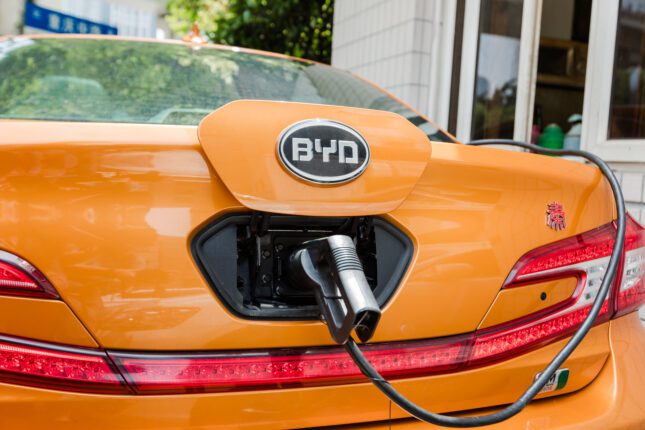-
China’s EV Power Grid-lock: A Coin Toss for Decarbonization?
January 25, 2024 By Yining ZouUsually, Ms. Li charges her BYD electric car at a TELD station during her half-hour lunch break. However, today was different – it took an extra ten minutes to complete the charging, providing her time to enjoy a cup of coffee. This slight delay was due to her participation in a Shanghai demand response pilot designed to encourage consumers to adjust electricity usage according to electricity grid conditions. Like a coin toss, this pilot could be a big win for protecting the grid and accelerating low-carbon transport in China, but many infrastructure obstacles could derail this decarbonization.
Heads: EVs and Renewables Fuel Decarbonization Boon
Ms. Li is one of millions of electric vehicle (EV) owners in Shanghai who took advantage of the free license plate policy for buying a new plug-in hybrid or battery electric car. In addition, consumers are cashing in on central and local government subsidies, tax exemptions, rebates, and other generous enticements. With these policies China has captured 60% of global EVs and led EV sales for 8 consecutive years. In the first half of 2023, China sold over 3.7 million EVs domestically, raising total EV ownership to 16+ million. By 2040, this figure is projected to surpass 300 million, saving 1 billion tons of CO2 emissions, equivalent to 2018 emissions in Shandong, one of China’s most coal-reliant provinces.
China also leads the world in renewables, installing over a third of global wind and solar energy. A whopping 31.6% of China’s electricity generation comes from renewable sources. The synergy between these two trends could propel China’s power grid toward a more sustainable and decarbonized future. The challenge lies in integrating vast amounts of intermittent renewable energy onto the grid while meeting the EV charging needs of millions.
Tails: EVs Gridlocking the Power Grid
Despite the idyllic depiction of driving the low-carbon future, the reality for EVs is far more challenging. Charging millions of EVs simultaneously during peak load periods could potentially overwhelm existing grid infrastructure and require considerable upgrades to fuel the EV revolution. This challenge could be particularly problematic in areas where the power grid is already under stress from heat waves and increasing peak electricity demand.
As part of major electricity grid reforms, China is planning to consolidate its six regional grids into a unified electricity market, as well as allow spot trading to help the grid respond faster to changes in supply and demand. With consistent state support and sufficient market incentives, China’s power grid could become stronger and capable of supporting both the EV boom and expanding renewables.
Winning the Toss with Vehicle-grid Integration
Vehicle-grid integration (VGI) encompasses a wide range of technical solutions to meet the charging demand of millions of EVs while enabling these vehicles to support the power grid. One common application of VGI is managed charging (V1G), where charging operators can control the time and power level of charging. Such as when TELD reduced its charging power Ms. Li’s car. In exchange for extra java time, Ms. Li helped prevent strain on Shanghai’s grid during a peak time.
VGI systems target EVs as a massive collection of “batteries on wheels.” China’s passenger EVs are only on-road driving for about 2 hours a day and charging for 7.4 hours a month, which means nearly 90% of the time they are sitting idle and can be utilized as power assets. If EV owners could shift charging to off-peak hours, such as at night, it would prevent power spikes and drops and contribute to a stable and reliable power supply.
The Chinese government and EV industry are also exploring how EVs can connect with grids to provide back up energy when needed. Once such systems are realized at scale, VGI bidirectional charging will empower EVs to offer an energy balancing ability comparable to but also cheaper than pumped hydro by 2030.
Shanghai Drives Ahead for a Healthier Grid Future
With 21 million citizens, Shanghai’s electricity consumption peaks are rising higher each year. The city’s downtown distribution grid faces can’t expand due to space and cost concerns. To soothe grid operations, Shanghai became the first demand response pilot city in 2014 to incentivize energy conservation. In 2019, Shanghai raised EV charging during off-peak hours 7.8 times higher than before, while peak-hour loads dropped by 75%. The pilot also proved the viability of VGI, providing a blueprint for other cities.
Strategies to Beat the Odds OR Paving the Way for Vehicle Grid Integration
Various government-led pilots in China are working to validate the feasibility of VGI and showcase how governments could incubate green and innovative solutions. However, the biggest obstacle to VGI pilot expansion is insufficient charging infrastructure. Public charging operators find difficulty in obtaining grid capacity approvals or appropriate parking lots to install charging stations in big cities. Another hurdle is the nascent power market; VGI pilots currently largely rely on government subsidies instead of generating revenue from providing grid flexibility. Recognizing the importance of addressing these issues, China’s central government has recently introduced a series of high-level policies aimed at integrating EVs into the power market, improving public charging accessibility, and uniting EVs with the power system.
In December 2023, China codified VGI into its policy framework, positioning EVs to be an integral part of the grid’s and setting VGI standards, residential peak-valley tariffs, and investing in distribution grid improvements. Beyond that, scaling up VGI will require coordinated urban land planning, open communication protocols, flexible pricing mechanisms, and an open power market. These measures will enable EVs to become a key demand-side resource to stabilize and decarbonize China’s grid.
Yining Zou was a former research assistant at the Wilson Center’s China Environment Forum in 2019. She is currently Senior Project Coordinator at NRDC China where she and her team work on China’s power sector decarbonization.
Sources: Bloomberg, Bonneville Power Administration, China Central Government, China Economic Net, ev connect, IEA, Kyos, NDRC, National Energy Administration (NEA), New Security Beat, National Development and Reform Commission (NDRC), Reuters, Shanghai Government, Sina, WRI, Zhenpo Wang
Header Photo Credit: Shanghai, China – May 6, 2016: Power supply for China BYD electric charging. Courtesy ofJ. Lekavicius/Shutterstock.com
 A Publication of the Stimson Center.
A Publication of the Stimson Center.








